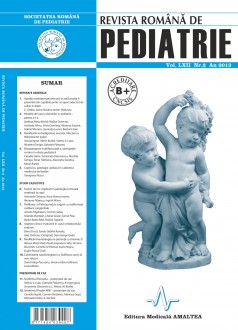SELECT ISSUE

Indexed

| |

|
|
|
| |
|
|
|

|
|
|
|
|
|
|
HIGHLIGHTS
National Awards “Science and Research”
NEW! RJP has announced the annually National Award for "Science and Research" for the best scientific articles published throughout the year in the official journal.
Read the Recommendations for the Conduct, Reporting, Editing, and Publication of Scholarly work in Medical Journals.
The published medical research literature is a global public good. Medical journal editors have a social responsibility to promote global health by publishing, whenever possible, research that furthers health worldwide.
Hematological changes in patients with trisomy 21
Raluca Maria Vlad, Paula Grigorescu Sido, Simona Bucerzan, Camelia Al-Khzouz, Ioana Naşcu and Eugen Pascal Ciofu
ABSTRACT
Background and aims. Children with trisomy 21 have an increased risk of hematological anomalies. The aim of the study was to evaluate the hematological characteristics of these patients and to correlate them with the cytogenetic findings.
Material and method. We conducted an observational study on 136 patients with trisomy 21 that were evaluated recording a complete hematological picture. The individual parameters for each patient were compared with reference values for age and were statistically evaluated considering the age groups and the cytogenetic anomalies.
Results. In 91.2% of the cases the diagnosis of regular trisomy 21 was established. 58.08% of patients had at least one hematological anomaly. 8.82% and 2.2% associated 2 or 3 anomalies respectively. No differences regarding the hematological parameters were found between patients with regular trisomy 21, mosaic or a combination of anomalies. 16.9% of patients presented with a form of anemia: macrocytic anemia and iron deficiency anemia 5.14% each. A tendency to lower than normal leukocyte counts for all age groups was recorded. The patients associated thrombocytopenia and thrombocytosis with the same frequency (3.67%). 1.47% developed acute leukemia.
Conclusions. 58% of patients in all age groups and 100% of newborns with trisomy 21 had at least one hematological anomaly. The most frequent were leukopenia (17.61%), anemia (16.91%) and macrocytosis (16.91%). No significant differences were found in relation to the cytogenetic diagnosis.
Key words: trisomy 21, hematological changes
